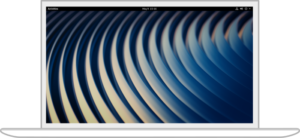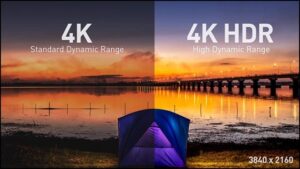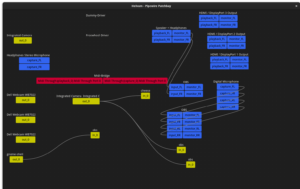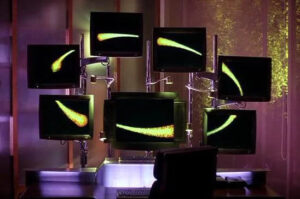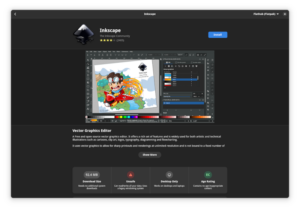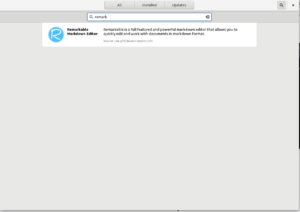I have wanted to write this blog post for quite some time, but been unsure about the exact angle of it. I think I found that angle now where I will root the post in a very tangible concrete example.
So the reason I wanted to write this was because I do feel there is a palpable skepticism and negativity towards AI in the Linux community, and I understand that there are societal implications that worry us all, like how deep fakes have the potential to upend a lot of things from news disbursement to court proceedings. Or how malign forces can use AI to drive narratives in social media etc., is if social media wasn’t toxic enough as it is. But for open source developers like us in the Linux community there is also I think deep concerns about tooling that deeply incurs into something that close to the heart of our community, writing code and being skilled at writing code. I hear and share all those concerns, but at the same time having spent time the last weeks using Claude.ai I do feel it is not something we can afford not to engage with. So I know people have probably used a lot of different AI tools in the last year, some being more cute than useful others being somewhat useful and others being interesting improvements to your Google search for instance. I think I shared a lot of those impressions, but using Claude this last week has opened my eyes to what AI enginers are going to be capable of going forward.
So my initial test was writing a python application for internal use at Red Hat, basically connecting to a variety of sources and pulling data and putting together reports, typical management fare. How simple it was impressed me though, I think most of us having to deal with pulling data from a new source know how painful it can be, with issues ranging from missing, outdated or hard to parse API documentation. I think a lot of us also then spend a lot of time experimenting to figure out the right API calls to make in order to pull the data we need. Well Claude was able to give me python scripts that pulled that data right away, I still had to spend some time with it to fine tune the data being pulled and ensuring we pulled the right data, but I did it in a fraction of the time I would have spent figuring that stuff out on my own. The one data source Claude struggled with Fedora’s Bohdi, well once I pointed it to the URL with the latest documentation for that it figured out that it would be better to use the bohdi client library to pull data and once it had that figured out it was clear sailing.
So coming of pretty impressed by that experience I wanted to understand if Claude would be able to put together something programmatically more complex, like a GTK+ application using Vulkan. [Note: should have checked the code better, but thanks to the people who pointed this out. I told the AI to use Vulkan, which it did, but not in the way I expected, I expected it to render the globe using Vulkan, but it instead decided to ensure GTK used its Vulkan backend, an important lesson in both prompt engineering and checking the code afterwards).]So I thought what would be a good example of such an application and I also figured it would be fun if I found something really old and asked Claude to help me bring it into the current age. So I suddenly remembered xtraceroute, which is an old application orginally written in GTK1 and OpenGL showing your traceroute on a 3d Globe.
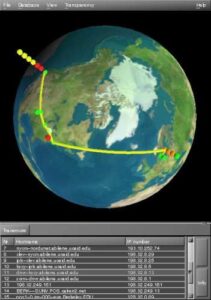
Screenshot of the original Xtraceroute application
I went looking for it and found that while it had been updated to GTK2 since last I looked at it, it had not been touched in 20 years. So I thought, this is a great testcase. So I grabbed the code and fed it into Claude, asking Claude to give me a modern GTK4 version of this application using Vulkan. Ok so how did it go? Well it ended up being an iterative effort, with a lot of back and forth between myself and Claude. One nice feature Claude has is that you can upload screenshots of your application and Claude will use it to help you debug. Thanks to that I got a long list of screenshots showing how this application evolved over the course of the day I spent on it.
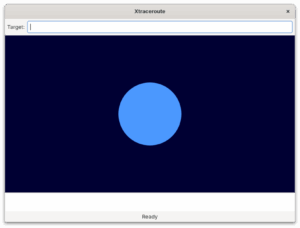
This screenshot shows Claudes first attempt of transforming the 20 year old xtraceroute application into a modern one using GTK4, Vulkan and also adding a Meson build system. My prompt to create this was feeding in the old code and asking Claude to come up with a GTK4 and Vulkan equivalent. As you can see the GTK4 UI is very simple, but ok as it is. The rendered globe leaves something to be desired though. I assume the old code had some 2d fall backcode, so Claude latched onto that and focused on trying to use the Cairo API to recreate this application, despite me telling it I wanted a Vulkan application. What what we ended up with was a 2d circle that I could spin around like a wheel of fortuen. The code did have some Vulkan stuff, but defaulted to the Cairo code.
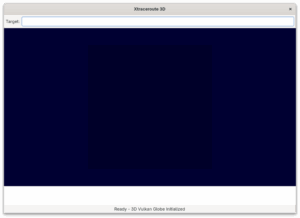
Second attempt at updating this application Anyway, I feed the screenshot of my first version back into Claude and said that the image was not a globe, it was missing the texture and the interaction model was more like a wheel of fortune. As you can see the second attempt did not fare any better, in fact we went from circle to square. This was also the point where I realized that I hadn’t uploaded the textures into Claude, so I had to tell it to load the earth.png from the local file repository.
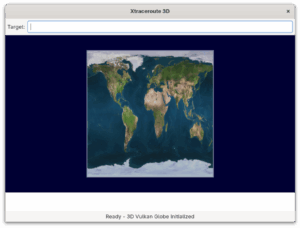
Third attempt from Claude.Ok, so I feed my second screenshot back into Claude and pointed out that it was no globe, in fact it wasn’t even a circle and the texture was still missing. With me pointing out it needed to load the earth.png file from disk it came back with the texture loading. Well, I really wanted it to be a globe, so I said thank you for loading the texture, now do it on a globe.
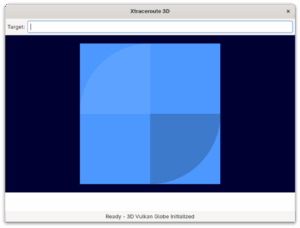
This is the output of the 4th attempt. As you can see, it did bring back a circle, but the texture was gone again. At this point I also decided I didn’t want Claude to waste anymore time on the Cairo code, this was meant to be a proper 3d application. So I told Claude to drop all the Cairo code and instead focus on making a Vulkan application.
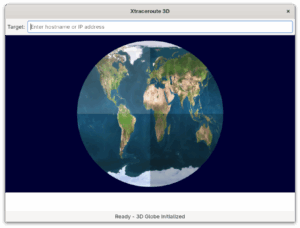
So now we finally had something that started looking like something, although it was still a circle, not a globe and it got that weird division of 4 thing on the globe. Anyway, I could see it using Vulkan now and it was loading the texture. So I was feeling like we where making some decent forward movement. So I wrote a longer prompt describing the globe I wanted and how I wanted to interact with it and this time Claude did come back with Vulkan code that rendered this as a globe, thus I didn’t end up screenshoting it unfortunately.
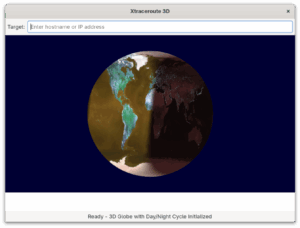
So with the working globe now in place, I wanted to bring in the day/night cycle from the original application. So I asked Claude to load the night texture and use it as an overlay to get that day/night effect. I also asked it to calculate the position of the sun to earth at the current time, so that it could overlay the texture in the right location. As you can see Claude did a decent job of it, although the colors was broken.
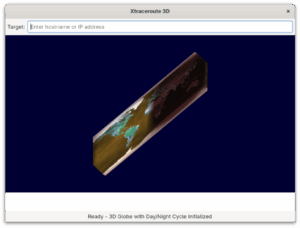
So I kept fighting with the color for a bit, Claude could see it was rendering it brown, but could not initally figure out why. I could tell the code was doing things mostly right so I also asked it to look at some other things, like I realized that when I tried to spin the globe it just twisted the texture. We got that fixed and also I got Claude to create some tests scripts that helped us figure out that the color issue was a RGB vs BRG issue, so as soon as we understood that then Claude was able to fix the code to render colors correctly. I also had a few iterations trying to get the scaling and mouse interaction behaving correctly.
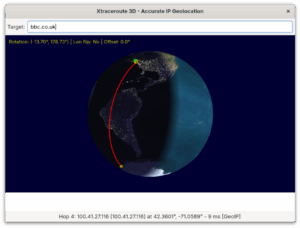
So at this point I had probably worked on this for 4-5 hours, the globe was rendering nicely and I could interact with it using the mouse. Next step was adding the traceroute lines back. By default Claude had just put in code to render some small dots on the hop points, not draw the lines. Also the old method for getting the geocoordinates, but I asked Claude to help me find some current services which it did and once I picked one it on first try gave me code that was able to request the geolocation of the ip addresses it got back. To polish it up I also asked Claude to make sure we drew the lines following the globes curvature instead of just drawing straight lines.
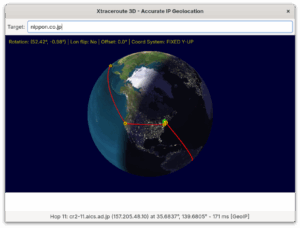
Final version of the updated Xtraceroute application. It mostly works now, but I did realize why I always thought this was a fun idea, but less interesting in practice, you often don’t get very good traceroutes back, probably due to websites being cached or hosted globally. But I felt that I had proven that with a days work Claude was able to help me bring this old GTK application into the modern world.
Conclusions
So I am not going to argue that Xtraceroute is an important application that deserved to be saved, in fact while I feel the current version works and proves my point I also lost motivation to try to polish it up due to the limitations of tracerouting, but the code is available for anyone who finds it worthwhile.
But this wasn’t really about Xtraceroute, what I wanted to show here is how someone lacking C and Vulkan development skills can actually use a tool like Claude to put together a working application even one using more advanced stuff like Vulkan, which I know many more than me would feel daunting. I also found Claude really good at producing documentation and architecture documents for your application. It was also able to give me a working Meson build system and create all the desktop integration files for me, like the .desktop file, the metainfo file and so on. For the icons I ended up using Gemini as Claude do not do image generation at this point, although it was able to take a png file and create a SVG version of it (although not a perfect likeness to the original png).
Another thing I want to say is that the way I think about this, it is not that it makes coding skills less valuable, AIs can do amazing things, but you need to keep a close eye on them to ensure the code they create actually do what you want and that it does it in a sensible manner. For instance in my reporting application I wanted to embed a pdf file and Claude initial thought was to bring in webkit to do the rendering. That would have worked, but would have added a very big and complex dependency to my application, so I had to tell it that it could just use libpoppler to do it, something Claude agreed was a much better solution. The bigger the codebase the harder it also becomes for the AI to deal with it, but I think it hose circumstances what you can do is use the AI to give you sample code for the functionality you want in the programming language you want and then you can just work on incorporating that into your big application.
The other part here if course in terms of open source is how should contributors and projects deal with this? I know there are projects where AI generated CVEs or patches are drowning them and that helps nobody. But I think if we see AI as a developers tool and that the developer using the tool is responsible for the code generated, then I think that mindset can help us navigate this. So if you used an AI tool to create a patch for your favourite project, it is your responsibility to verify that patch before sending it in, and with that I don’t mean just verifying the functionality it provides, but that the code is clean and readable and following the coding standards of said upstream project. Maintainers on the other hand can use AI to help them review and evaluate patches quicker and thus this can be helpful on both sides of the equation. I also found Claude and other AI tools like Gemini pretty good at generating test cases for the code they make, so this is another area where open source patch contributions can improve, by improving test coverage for the code.
I do also believe there are many areas where projects can greatly benefit from AI, for instance in the GNOME project a constant challenge for extension developers have been keeping their extensions up-to-date, well I do believe a tool like Claude or Gemini should be able to update GNOME Shell extensions quite easily. So maybe having a service which tries to provide a patch each time there is a GNOME Shell update might be a great help there. At the same time having a AI take a look at updated extensions and giving an first review of the update might help reduce the load on people doing code reviews on extensions and help flag problematic extensions.
I know for a lot of cases and situations uploading your code to a webservice like Claude, Gemini or Copilot is not something you want or can do. I know privacy is a big concern for many people in the community. My team at Red Hat has been working on a code assistant tool using the IBM Granite model, called Granite.code. What makes Granite different is that it relies on having the model run locally on your own system, so you don’t send your code or data of somewhere else. This of course have great advantages in terms of improving privacy and security, but it has challenges too. The top end AI models out there at the moment, of which Claude is probably the best at the time of writing this blog post, are running on hardware with vast resources in terms of computing power and memory available. Most of us do not have those kind of capabilities available at home, so the model size and performance will be significantly lower. So at the moment if you are looking for a great open source tool to use with VS Code to do things like code completion I recommend giving Granite.code a look. If you on the other hand want to do something like I have described here you need to use something like Claude, Gemini or ChatGPT. I do recommend Claude, not just because I believe them to be the best at it at the moment, but they also are a company trying to hold themselves to high ethical standards. Over time we hope to work with IBM and others in the community to improve local models, and I am also sure local hardware will keep improving, so over time the experience you can get with a local model on your laptop at least has less of a gap than what it does today compared to the big cloud hosted models. There is also the middle of the road option that will become increasingly viable, where you have a powerful server in your home or at your workplace that can at least host a midsize model, and then you connect to that on your LAN. I know IBM is looking at that model for the next iteration of Granite models where you can choose from a wide variety of sizes, some small enough to be run on a laptop, others of a size where a strong workstation or small server can run them or of course the biggest models for people able to invest in top of the line hardware to run their AI.
Also the AI space is moving blazingly fast, if you are reading this 6 Months from now I am sure the capabilities of online and local models will have changed drastically already.
So to all my friends in the Linux community I ask you to take a look at AI and what it can do and then lets work together on improving it, not just in terms of capabilities, but trying to figure out things like societal challenges around it and sustainability concerns I also know a lot of us got.
Whats next for this code
As I mentioned I while I felt I got it to a point where I proved to myself it worked, I am not planning on working anymore on it. But I did make a cute little application for internal use that shows a spinning globe with all global Red Hat offices showing up as little red lights and where it pulls Red Hat news at the bottom. Not super useful either, but I was able to use Claude to refactor the globe rendering code from xtraceroute into this in just a few hours.
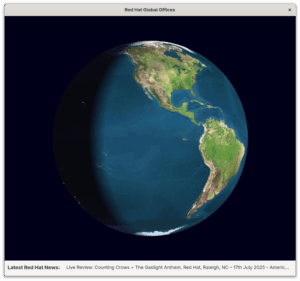
Red Hat Offices Globe and news.

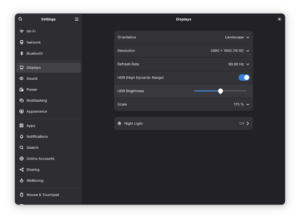
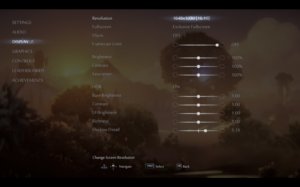
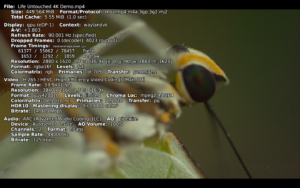
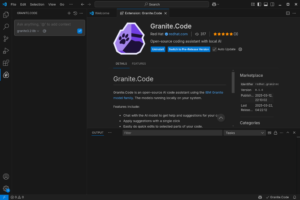
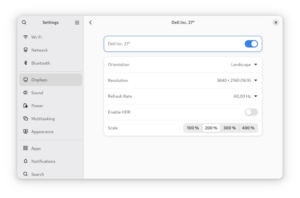
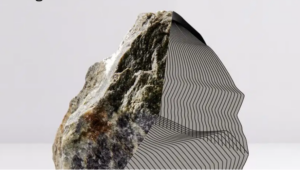


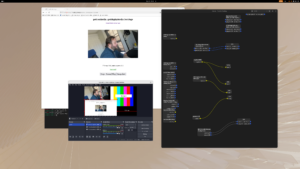
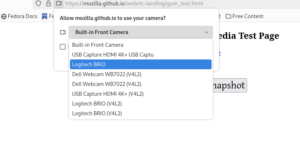
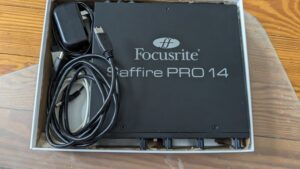
 PipeWire keeps the Linux Multimedia revolution rolling[/caption]So lets start with one of your favorite topics, PipeWire. As you probably know PipeWire 1.0 is now out and I feel it is a project we definitely succeeded with, so big kudos to Wim Taymans for leading this effort. I think the fact that we got both the creator of JACK, Paul Davis and the creator of PulseAudio Lennart Poettering to endorse it means our goal of unifying the Linux audio landscape is being met. I include their endorsement comments from the PipeWire 1.0 release announcement here :
PipeWire keeps the Linux Multimedia revolution rolling[/caption]So lets start with one of your favorite topics, PipeWire. As you probably know PipeWire 1.0 is now out and I feel it is a project we definitely succeeded with, so big kudos to Wim Taymans for leading this effort. I think the fact that we got both the creator of JACK, Paul Davis and the creator of PulseAudio Lennart Poettering to endorse it means our goal of unifying the Linux audio landscape is being met. I include their endorsement comments from the PipeWire 1.0 release announcement here : HDR, or High Dynamic Range, is another major effort for us. HDR is a technology I think many of you have become familiar with due to it becoming quite common in TVs these days. It basically provides for greatly increased color depth and luminescence on your screen. This is a change that entails a lot of changes through the stack, because when you introduce into an existing ecosystem like the Linux desktop you have to figure out how to combine both new HDR capable applications and content and old non-HDR applications and content.
HDR, or High Dynamic Range, is another major effort for us. HDR is a technology I think many of you have become familiar with due to it becoming quite common in TVs these days. It basically provides for greatly increased color depth and luminescence on your screen. This is a change that entails a lot of changes through the stack, because when you introduce into an existing ecosystem like the Linux desktop you have to figure out how to combine both new HDR capable applications and content and old non-HDR applications and content.  Accessibility is an important feature for us in Fedora Workstation and thus we hired
Accessibility is an important feature for us in Fedora Workstation and thus we hired 
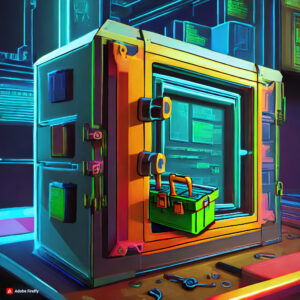 As we continue marching towards a vision for Fedora Workstation to be a highly robust operating we keep evolving
As we continue marching towards a vision for Fedora Workstation to be a highly robust operating we keep evolving  Another effort that Fedora Workstation has brought to the world of Linux and that is very popular arethe LVFS and fwdup formware update repository and tools. Thanks to that effort we are soon going to be passing one hundred million firmware updates on Linux devices soon! These firmware updates has helped resolve countless bugs and much improved security for Linux users.
Another effort that Fedora Workstation has brought to the world of Linux and that is very popular arethe LVFS and fwdup formware update repository and tools. Thanks to that effort we are soon going to be passing one hundred million firmware updates on Linux devices soon! These firmware updates has helped resolve countless bugs and much improved security for Linux users. 